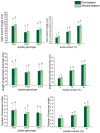Response of Growth, Yield, and Phytochemical Behavior of Jojoba Genotypes to Azolla filiculoides Plant Extract
- PMID: 35631739
- PMCID: PMC9144622
- DOI: 10.3390/plants11101314
Response of Growth, Yield, and Phytochemical Behavior of Jojoba Genotypes to Azolla filiculoides Plant Extract
Abstract
A unique storage lipid wax found in jojoba seeds can be employed as a chemical feedstock. Alternative safe and natural sources of plant nutrients are constantly sought to preserve both human health and the environment. As a result, EAI1, EAI2, and EAI3 jojoba genotypes' growth, yield, and phytochemical behavior in response to Azolla extract at concentrations of 0, 10, and 30% were studied. Maximum productivity was found with EAI1, followed by EAI3 then EAI2 across all Azolla extracts. In relation to the Azolla extract concentrations in the two seasons, the concentration of 30% delivered the most pronounced results across all the studied genotypes. During the two seasons, administration of a combined treatment of the EAI1 jojoba genotype with 30% Azolla extract produced the highest mean values of growth, flowering, and fruiting, as well as chemical composition parameters. This means that the treatment of EAI1 genotype with 30% Azolla filiculoides Lam. plant extract yielded the highest significant seed yield (3748 and 3839 kg ha-1) and oil yield per hectare (1910 and 2002 L ha-1). The combination treatment of the EAI1 jojoba genotype with 10% Azolla extract yielded the highest proportion of gadoleic fatty acid (49.83%).
Keywords: Azolla extract; fatty acids; gadoleic acid; growth; jojoba genotypes; yield.
Conflict of interest statement
The authors declare no conflict of interest.
Figures







References
-
- Nelson J.M., Watson J.E. Nitrogen fertilization effects on jojoba seed production. Ind. Crops Prod. 2001;13:145–154. doi: 10.1016/S0926-6690(00)00061-3. - DOI
-
- Phillips S.J., Patricia W.C., editors. A Natural History of the Sonoran Desert. University of California Press; Berkeley, CA, USA: 2001. pp. 256–257.
-
- Wisniak J. The Chemistry and Technology of Jojoba Oil. American Oil Chemists’ Society; Champaign, IL, USA: 1987.
-
- US National Research Council . Jojoba: New Crop for Arid Lands, New Material for Industry. National Academy Press; Washington, DC, USA: 1985.
-
- Guardiola J.L. Fruit set and growth. In: Donadio L.C., editor. Second International Seminar on Citrus. Univ of Bebedouro; São Paulo, Brazil: 1992. pp. 1–30.
LinkOut - more resources
Full Text Sources
Research Materials

